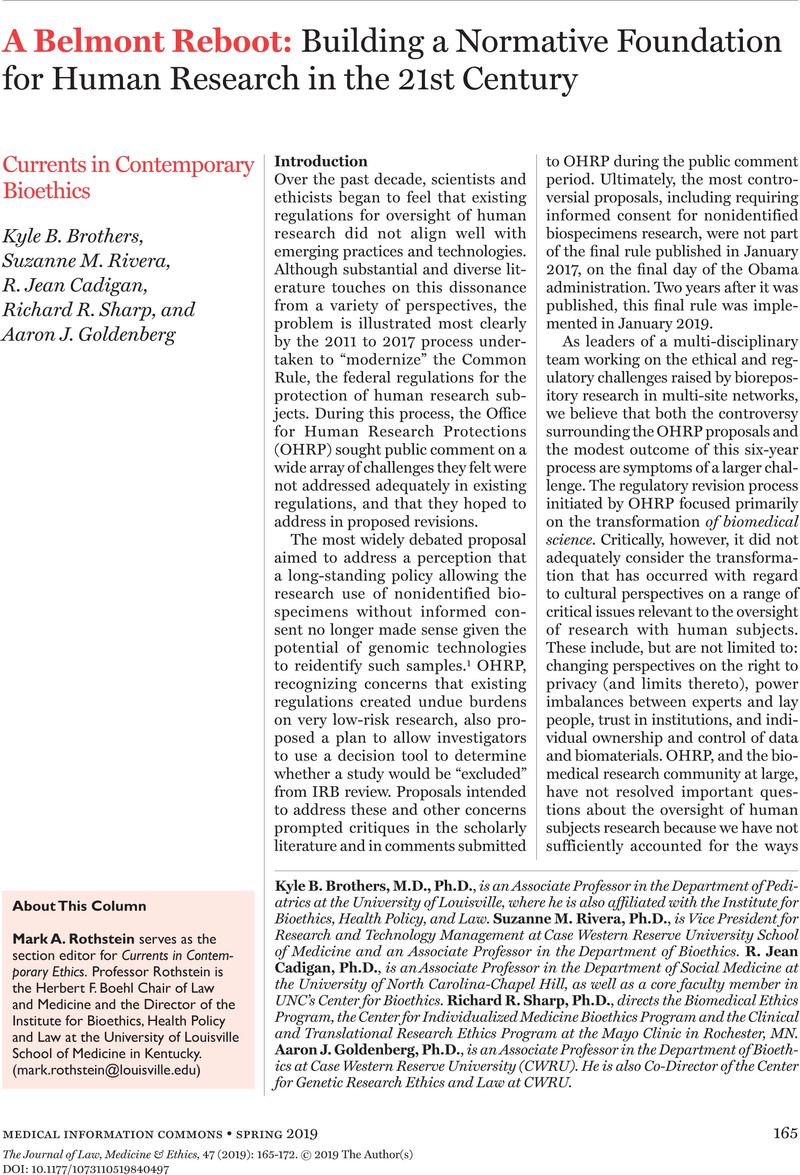Crossref Citations
This article has been cited by the following publications. This list is generated based on data provided by Crossref.
Rothstein, Mark A.
Zawati, Ma'n H.
Beskow, Laura M.
Brelsford, Kathleen M.
Brothers, Kyle B.
Hammack-Aviran, Catherine M.
Hazel, James W.
Joly, Yann
Lang, Michael
Patrinos, Dimitri
Saltzman, Andrea
and
Knoppers, Bartha Maria
2019.
Legal and Ethical Challenges of International Direct-to-Participant Genomic Research: Conclusions and Recommendations.
Journal of Law, Medicine & Ethics,
Vol. 47,
Issue. 4,
p.
705.
Morain, Stephanie R.
Weinfurt, Kevin
Bollinger, Juli
Geller, Gail
Mathews, Debra JH
and
Sugarman, Jeremy
2020.
Ethics and Collateral Findings in Pragmatic Clinical Trials.
The American Journal of Bioethics,
Vol. 20,
Issue. 1,
p.
6.
Huh-Yoo, Jina
and
Rader, Emilee
2020.
It's the Wild, Wild West: Lessons Learned From IRB Members' Risk Perceptions Toward Digital Research Data.
Proceedings of the ACM on Human-Computer Interaction,
Vol. 4,
Issue. CSCW1,
p.
1.
Schleidgen, Sebastian
and
Brothers, Kyle B.
2020.
Secondary Findings in Genomic Research.
p.
77.
Siddiqui, Wamia
and
Sharp, Richard R.
2021.
Beyond the Belmont Report.
The American Journal of Bioethics,
Vol. 21,
Issue. 10,
p.
1.
Balladares Chávez, María del Pilar
2022.
Actitudes hacia la investigación en estudiantes de un programa de segunda especialidad en enfermería en cuidados intensivos.
Revista Cuidado y Salud Pública,
Vol. 2,
Issue. 2,
p.
22.
Nagai, Hiroyuki
Nakazawa, Eisuke
and
Akabayashi, Akira
2022.
The creation of the Belmont Report and its effect on ethical principles: a historical study.
Monash Bioethics Review,
Vol. 40,
Issue. 2,
p.
157.
Waters, Donna
2022.
Paediatric Nursing in Australia and New Zealand.
p.
82.
Matta Solis, Diana Karim
2022.
Empatía en internos de un programa de enfermería en Lima, 2022.
Revista Cuidado y Salud Pública,
Vol. 2,
Issue. 2,
p.
36.
Matta Solis, Silvia Cristina
2022.
Engagement en personal de salud de un policlínico privado de Lima Norte.
Revista Cuidado y Salud Pública,
Vol. 2,
Issue. 2,
p.
50.
2022.
Paediatric Nursing in Australia and New Zealand.
p.
1.
Tacas Yarcuri, Victoria
2022.
Capacidad resiliente en personas con bajos ingresos que reciben asistencia alimentaria en una zona de El Agustino.
Revista Cuidado y Salud Pública,
Vol. 2,
Issue. 2,
p.
43.
Carranza Manrique, Elizabeth
2022.
Calidad de vida en pacientes con pie diabético que acuden a su control de salud en una clínica de Lima-Norte.
Revista Cuidado y Salud Pública,
Vol. 2,
Issue. 2,
p.
3.
Edonis Haro, Eugenia
2022.
Inteligencia emocional en enfermeros del servicio de emergencia de un establecimiento sanitario ubicado en Lima Norte.
Revista Cuidado y Salud Pública,
Vol. 2,
Issue. 2,
p.
29.
Zegarra Soto, Alexandra Celeste
2022.
Estilos de vida saludable en adolescentes de una institución educativa privada ubicada en Lima Norte, 2022..
Revista Cuidado y Salud Pública,
Vol. 2,
Issue. 2,
p.
12.
Zegarra Soto, Alexandra Celeste
2023.
Conocimiento sobre prevención de anemia en madres de niños menores de 2 años de un establecimiento hospitalario en Lima Norte.
Revista Cuidado y Salud Pública,
Vol. 3,
Issue. 1,
p.
56.
Selin, Cynthia
Lambert, Lauren
Morain, Stephanie
Nelson, John P.
Barlevy, Dorit
Farooque, Mahmud
Manley, Haley
and
Scott, Christopher T.
2023.
Researching the future: scenarios to explore the future of human genome editing.
BMC Medical Ethics,
Vol. 24,
Issue. 1,
Alvarado Loayza, Gina Maria
2023.
Ansiedad generalizada en internos de un programa de enfermeria: un estudio transversal.
Revista Cuidado y Salud Pública,
Vol. 3,
Issue. 1,
Borda Lozano, Cecilia
2023.
Calidad de vida en personas con diabetes tipo 2 que acuden a un estableciniento de salud de atención primaria en Comas .
Revista Cuidado y Salud Pública,
Vol. 3,
Issue. 1,
p.
8.
Torlone, Francesca
2023.
Re-thinking Adult Education Research. Beyond the Pandemic.
Vol. 16,
Issue. ,
p.
111.





